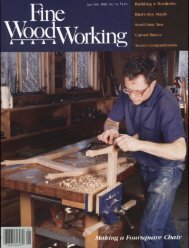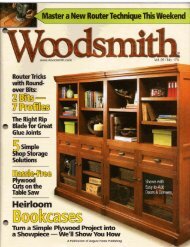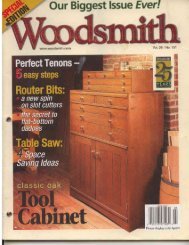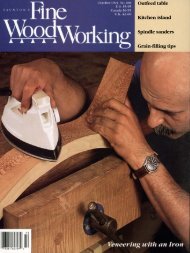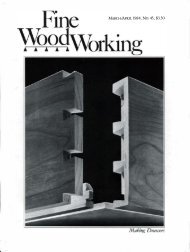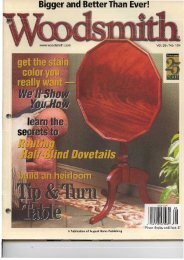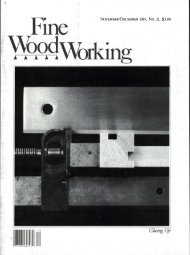Shaping with a Router - MetosExpo - Free
Shaping with a Router - MetosExpo - Free
Shaping with a Router - MetosExpo - Free
Create successful ePaper yourself
Turn your PDF publications into a flip-book with our unique Google optimized e-Paper software.
Q & A (continued)<br />
Ed Cowern replies: Speed controls offered for universal motors<br />
will not work <strong>with</strong> induction motors. The speed of an induction<br />
motor is set by the way the motor is wound (number of<br />
magnetic poles) and the frequency of the power being used. In<br />
most of North America, the frequency is 60 cycles while overseas<br />
most power is supplied at a frequency of 50 cycles. Speed controls<br />
for universal motors change only the voltage to the motor.<br />
In induction motors, used on most fixed power tools, adjusting<br />
the voltage will decrease the torque available from the motor for<br />
starting but will not control speed.<br />
The only effective way to dlange the speed of power tools <strong>with</strong><br />
induction motors is by changing the frequency to a different value,<br />
and this is an expensive process. The most practical way to change<br />
tile speed of an induction motor in a small shop is to employ mechanical<br />
means, such as step pulleys. By using a matd1ing pair of<br />
step pulleys on both the motor drive shaft and the arbor shaft of<br />
tile machine, you can dloose from three or four (depending on<br />
tile pulleys) different speeds as quickly as you can slip me v belt<br />
from one position on tile pulleys to anomer.<br />
[Ed Cowern is an electrical engineer and president of EMS, a<br />
company that distributes Baldor electric motors.]<br />
Drying spalted logs<br />
I have a supply 0/ logs that are damp and many 0/ which<br />
contain lovely spalted wood. Should I resaw the logs into<br />
lumber now and stack the resulting boards under pressure to<br />
minimize warping, or should I let the logs dry naturally first?<br />
-Robert K Moxon, M.D., Columbia, S. C<br />
Bruce Hoadley replies: I would end coat and then resaw the<br />
spalted logs into slabs, flitches or boards now. Make sure to saw<br />
me stock slightiy thicker than what's desired for use, to provide<br />
shrinking and dressing allowances. Sawing tile logs now and initiating<br />
drying will arrest the development of me fungi and prevent<br />
extensively spalted areas from progressing to tile advanced decay<br />
stage. Further, tile best pieces can be selected and given special<br />
attention in dlying; tile badly decayed or unspalted portions can be<br />
discarded. As <strong>with</strong> any material, stacking in well-stickered, weighted<br />
piles will enable the most efficient drying <strong>with</strong> minimum warp.<br />
[Bruce Hoadley is professor of wood technology at the University<br />
of Massachusetts at Amherst and a contributing editor to FWW]<br />
Sheet goods and formaldehyde safety<br />
I own a small cabinet shop in western Washington and have<br />
been building cabinets for nearly 20 years. The growing popularity<br />
0/ particleboard sheet goods, such as Kortron and melamine,<br />
now widely used in casework, has made me more<br />
concerned about exposure to the formaldehyde that's said to<br />
be offgased by these products (my customers are concerned<br />
too). How much 0/ a health threat is there from working <strong>with</strong><br />
these sheet goods? -Joe Ciskowski, Eastsound, Wash.<br />
Chris Minick replies: The subject of me release of formaldehyde<br />
from manufactured wood products has been researdled for<br />
years by bom particleboard manufacturers and government agencies.<br />
A brief explanation of where tile formaldehyde comes from<br />
and what can be done about it is in order. Formaldehyde is liberated<br />
from me adhesive used in the manufacture of particleboard,<br />
medium density fiberboard (MDF), and hardwood plywood during<br />
the adhesive bonding step of the production process. Some of this<br />
formaldehyde becomes trapped in the wood product and is slowly<br />
released to me atmosphere over a period of several montils.<br />
The most common human reaction to high formaldehyde levels<br />
in the air is excessive eye blinking, eye irritation and respiratOlY<br />
(/)<br />
<br />
0 III<br />
rn<br />
• ROUTER TABLES · INCRA »<br />
FREE OJ<br />
CATALOG<br />
II<br />
»<br />
(/)<br />



